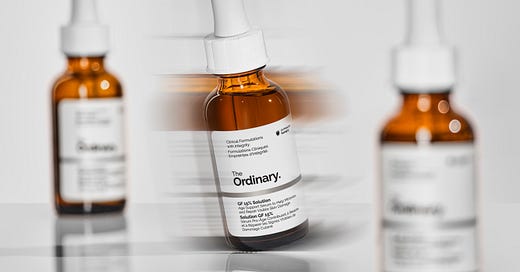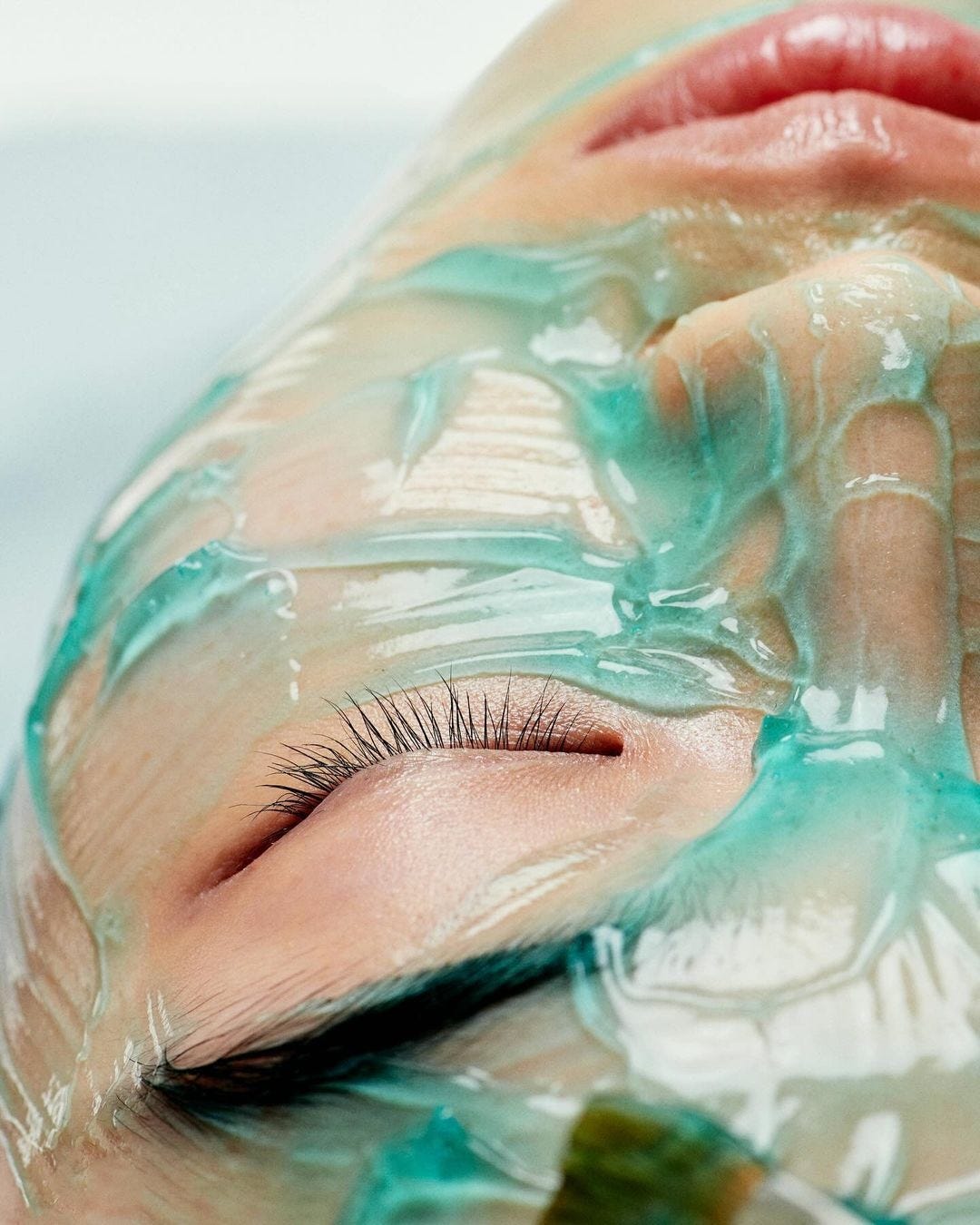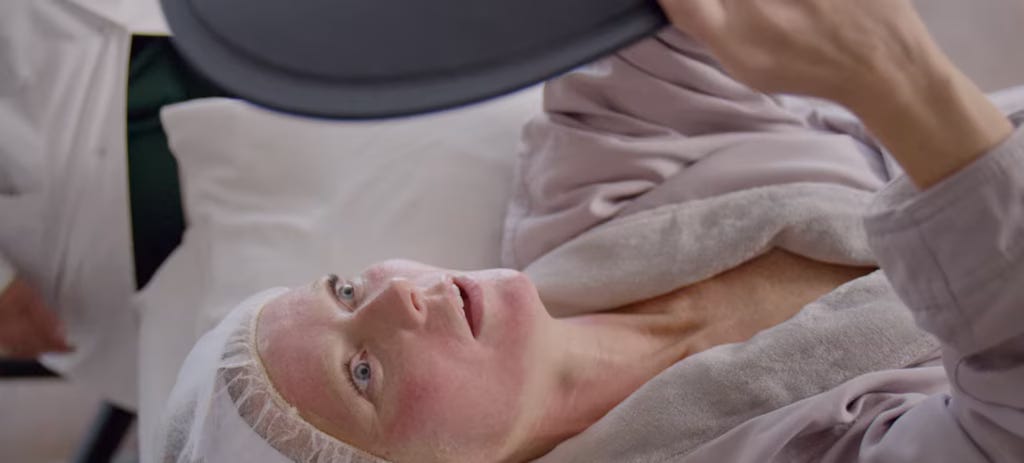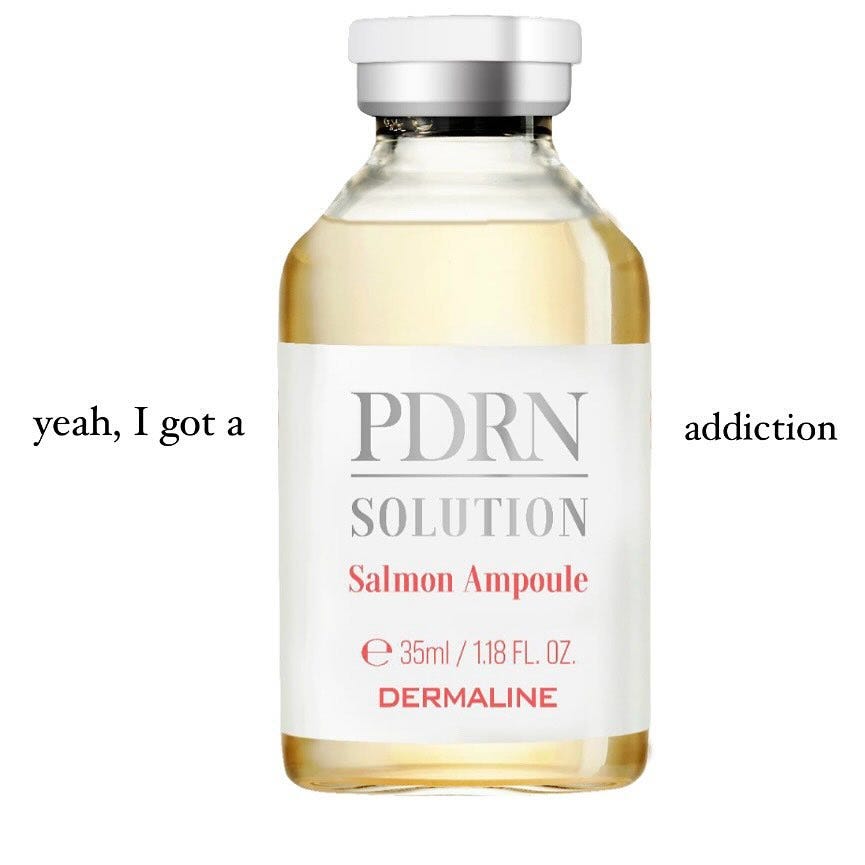Regenerative skincare: unlocking the future of skin health
an intro to bio-stimulants and a conversation with The Ordinary on growth factors, product testing, and if you should apply your hyaluronic acid serum on damp skin.
Hi! The world of bio-stimulants can be a bit puzzling to navigate, so this letter is slightly more science-heavy than usual. I hope I can give you some clarity on this complex subject so you can make informed choices! <3
Scientific skincare is on the rise and I don’t see it stopping anytime soon. The latest beauty trends are to be found in regenerative skincare. We’ve flirted with the idea of bio-stimulants before, but now it’s time to dive deep and go geeky. With The Ordinary dropping their shiny new regenerative skincare product this January, what better time to geek out over the science and hear straight from the team? Let’s get into it.
But first: what is regenerative skincare anyway?
Think of regenerative skincare as your skin’s personal trainer, or an engineer if you will, but on a cellular level. While traditional skincare plays the role of a friendly hydrator or surface-level brightener, regenerative skincare dives into the deeper stuff, stimulating your skin’s natural repair mechanisms to rebuild, renew, and restore. It’s about texture, vitality, and tackling those pesky visible signs of ageing like fine lines, wrinkles, and elasticity loss.
This approach isn’t just for skincare enthusiasts with a shelf of serums; regenerative skincare is for anyone looking to give their skin a fresh start. Whether you’re navigating the aftermath of environmental villains like pollution and UV rays or looking to rewind the clock on ageing, regenerative treatments could be your new obsession.
Gwyneth Paltrow getting a PRP microneedling treatment during her The Goop Lab show
The (slightly bloody) magic of in-office treatments
If you’ve ever heard of “vampire facials,” you’re already familiar with PRP. These in-office treatments are where regenerative skincare gets its dramatic flair:
PRP (Platelet-Rich Plasma): The OG of blood-based treatments, made famous by a bloody selfie of Kim Kardashian back in 2013. Your blood is drawn, spun down to isolate platelets, and then microneedled or injected into your skin. Not for the faint of heart. The goal? Stimulate collagen production and leave you with seemingly “younger” skin.
PRFM (Platelet-Rich Fibrin Matrix): Take PRP, slow-spin it to extract even more growth factors, and you’ve got PRFM. It’s like PRP’s fancier, more refined cousin, known for being richer and more potent in delivering regenerative goodness.
Exosomes: The new kid on the block. These microscopic messengers, derived from sources like umbilical cords(!) and bone marrow, deliver growth factors directly to skin cells. Exosomes are packed with promise but remain controversial due to sourcing concerns and their lack of regulatory clearance in Europe (EMA), the UK (MHRA), and the US (FDA).
PDRN: a DNA-derived compound extracted from salmon or trout sperm. It’s composed of nucleotides (the building blocks of DNA) that are known for their regenerative properties. It stimulates cell repair, enhances tissue regeneration, and boosts collagen production by activating receptors in skin cells (like adenosine receptors). Like many trends, it has been popular in South Korea for a while but has only recently entered the Western beauty space.
Stem Cells: Before there was PRP or exosomes, there were stem cells - the unsung heroes of regenerative medicine. These undifferentiated cells sparked decades of research into how our bodies heal and repair. While their potential in aesthetics faced hurdles (ethical concerns and the challenge of getting live stem cells to work on the skin), their legacy lives on in the form of stem cell-derived growth factors and media used in both skincare and in-office treatments. And - I suspect because of scientific developments - they seem to be having a freshly sparked moment these days. As seen at the Golden Globes last week, where one winner got a goodie bag containing a “stem cell facelift” worth $40k by dr. Simon Ourian.
All these treatments share one common element (except PDRN, which works indirectly): growth factors, the molecules that make the magic happen.
While exosomes are seen as the next big thing, the hunt for contamination free, biotech-produced exosomes is still on. Until then, there’s a simpler, less intimidating option: growth factors in topical skincare products.
by @ dewydudes on instagram
The rise of growth factors in skincare
So here’s the deal: growth factors are the tiny heroes naturally found in your body, present in your saliva and blood plasma, and they play a key role in wound healing.
They are a key element or common denominator in these regenerative treatments that we talked about above, although these therapies involve additional mechanisms and substances.
Growth factors are naturally occurring proteins or peptides. These molecules act like messengers, telling your skin to get to work producing collagen, elastin, and hyaluronic acid - aka the holy trinity of smooth, plump, and hydrated skin.
As we age, our natural supply of growth factors dwindles. The result? A slowdown in repair processes, leading to dullness, fine lines, wrinkles, and that frustrating loss of firmness.
This is why it’s so great that growth factors in skincare are finally entering the main chat, because they were pretty exclusive up until now.
The Ordinary’s GF 15% Solution is shaking things up, delivering a high dose of these powerhouse molecules at a price point that won’t make your wallet weep. Finally, growth factors are no longer reserved for the ultra-rich or those willing to endure in-office treatments.
Who are growth factors for?
Spoiler: everyone. But here’s who will see the biggest wins:
Anyone battling fine lines and wrinkles
Those noticing a loss of firmness or elasticity
People dealing with uneven texture or a general case of dull skin
City dwellers or sun lovers grappling with environmental damage
Incorporating growth factors into your routine is as simple as it is effective. Use them in the evening, after cleansing and toning, and before your moisturiser. As always, consistency is KEY for best results.
Let’s explore how The Ordinary is blending science, transparency, and accessibility in skincare
In this interview, The Ordinary’s science communicator Joseph Basham gives us an insider's perspective on why growth factors are trending, how they work, and what makes The Ordinary’s approach refreshingly honest and science-backed. Along the way, we’ll dive into clinical testing, sustainability challenges, and the brand’s cheeky-yet-smart advertising.
Skincare fans today range from complete beginners to ingredient enthusiasts. How does The Ordinary manage to keep both groups interested?
Joseph: From early on, our approach has been about giving people the tools to understand skincare. Even our product names, like "Niacinamide 10% + Zinc 1%," were designed to be straightforward and informative. By putting the ingredients front and centre, we sort of nudged people to research and learn more about what they’re putting on their skin.
Whether it was intentional or not, this transparency naturally encouraged curiosity. People didn’t just see a “hydrating serum”, they learned that the hydration comes from hyaluronic acid. And that approach still guides us today.
We’ve since built a whole education structure around this idea. Now, we have a scientific communications team that acts as a bridge between the labs and everyone else: from our brand team to our customers. We train our store teams thoroughly, so when you ask them a question, they’re ready with answers. We also work with pharmacists in the UK, social media teams, and other departments to make sure accurate information gets out there.
It’s all about helping people feel informed and confident when they pick up one of our products.
I love that, and I really feel like The Ordinary has played a big role in consumer education within the skincare industry, especially when it comes to ingredients.
I always like to be humble but I’d like to think so. I think we’ve contributed to a wider interest in skincare, but it’s also part of a bigger trend. During the pandemic, people had time to really dive into learning about their skin and the products they use. And that interest hasn’t gone away, even now that they are busier. The desire to know why a product works - and not just take it at face value - is stronger than ever.
Speaking of ingredient deep dives, growth factors are garnering significant attention, especially with treatments like PRP, PRFM, and exosomes. How do topical growth factors fit into this trend?
It’s important to understand the difference. In-office treatments like PRP micro-needling work on deeper layers of the skin. Topical cosmetics, like our GF 15% Solution, focus on surface-level benefits. While we don’t claim to match the results of in-office treatments, growth factors in skincare support the skin’s repair process. They help with concerns like fine lines, firmness, and radiance. Our formula provides immediate smoothness and radiance, and with consistent use, you see improvements in fine lines, wrinkles, and elasticity.
Yeah, I think topical products can offer a great non-invasive alternative or can even complement in-office treatments. Both approaches are effective in their own ways. Given that, how does The Ordinary ensure the efficacy of its products?
We’re meticulous about testing. First, we do in-house testing in our clinical research labs. Then, we send products for third-party in vitro (lab-based) testing and in vivo (on human volunteers) clinical trials. We prioritise measured data over subjective feedback, using trained assessors, instrumental readings, and imaging. This ensures our claims are backed by objective science, not just perception.
What do you think is driving the surge in interest around growth factors and regenerative skincare?
There are several reasons growth factors are having a moment right now. For one, consumer interest in skincare has evolved. People today want products that are more than just trendy, they’re looking for formulas that are backed by science and proven to work. Growth factors fit perfectly into this shift because they offer both preventive and reparative benefits.
At the same time, in-office treatments like PRP micro-needling have made growth factors more widely known. The idea of getting those regenerative benefits from an at-home product, without the intimidating price tag or clinical setting, is incredibly appealing.
And from a brand perspective: thanks to advances in biotechnology, producing growth factors has become much more affordable. We’re now able to create plant-based, biomimetic versions that mimic the skin’s natural repair processes and offer them at a price that’s accessible to more people than ever before.
I admire how The Ordinary avoids the fear-based rhetoric that is pretty common in “clean beauty.” Your focus on facts and transparency stands out. Is this an idealistic choice?
It’s core to who we are. We don’t believe in fear-mongering. Just because an ingredient sounds complex doesn’t mean it’s harmful. Our goal is to empower consumers through knowledge, not scare them. This extends to our sustainability practices. We’re honest about not being fully sustainable yet because true sustainability in beauty is a challenge. We’re making incremental changes, and we’d rather be truthful than make misleading claims.
Yeah I read DECIEM’s sustainability statement and like the whole communication strategy around the brand, I really love it. It’s such a refreshing statement in a world full of greenwashing:
‘DECIEM is not a sustainable beauty company, as we don’t have all the answers—yet. DECIEM was founded on transparency, and we believe that any business based on consumption (including ours) cannot be truly and fully sustainable within the current limits of sustainability in business. We are working hard to ensure that we are minimising our impact, but don't have all the answers figured out, and we want to be transparent about where we are on this journey’
Thank you! It’s impossible to produce and sell products without some environmental impact, and we’re not going to pretend otherwise. Instead, we focus on making consistent, incremental improvements across the board.
Our sustainability efforts include everything from reducing packaging waste to supporting local communities through charitable donations. We’re also integrating our sustainability team directly with our scientific department, which helps ensure that every decision we make is grounded in data and research rather than just marketing trends.
One thing we’re particularly proud of is our transparency. We’re constantly exploring new ways to minimise our impact, but we’re careful not to make claims we can’t fully back up. Sometimes this means we don’t talk enough about the positive steps we’re taking out of fear of being perceived as greenwashing. But ultimately, we believe it’s better to be honest and transparent than to over-promise and under-deliver.
The Ordinary’s advertising is refreshingly clever and educational. I loved the out of home campaign explaining that everything is a chemical. What’s the philosophy behind your marketing?
Initially, we relied on word-of-mouth and press support. When we started advertising, we kept it tongue-in-cheek but science-focused. That ad you mentioned is a great example. It’s transparent, a bit cheeky, and reinforces our values. Another favourite is the one where we joked about needing a celebrity with a biochemistry degree. Because science, not hype, is our priority.
How do you decide if a product becomes a hero in your lineup?
Our process is "lab to brand," not "marketing to lab." We experiment and learn as we go. Some ingredients, like niacinamide and hyaluronic acid, became heroes through consumer feedback and clinical success. We’re always open to reformulating based on feedback, like we did with our Hyaluronic Acid 2% + B5. It’s about listening, testing, and improving.
Any behind-the-scenes stories that reflect The Ordinary’s philosophy?
One of my favourites is the hyaluronic acid myth-busting. There’s a belief that hyaluronic acid works better on wet skin. I was tired of the unsubstantiated claims, so we ran clinical tests. The result? No significant difference between applying it to wet or dry skin. What matters is applying a moisturiser afterward to seal in hydration. This kind of rigorous, curiosity-driven testing embodies our approach.
That is so exciting that you get to do scientific myst busting like that, I’m jealous! Thank you so much for your time and insights!
It was a pleasure!
The Ordinary’s GF 15% Solution (€16,40) is in store from today, continuing the brand’s mission to make science-backed innovation accessible to everyone.
You can find the Amsterdam DECIEM store at Runstraat 10 (9 straatjes)
Thanks for reading Soft Glow!
Vogue Ukraine by Zoe Kovacs












